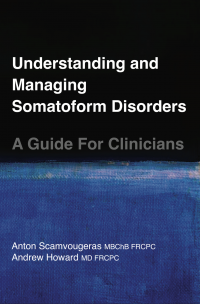- Last edited on December 13, 2021
Somatic Disorders
Primer
Somatic Disorders (formerly Somatoform Disorders) are mental health disorders characterized by prominent somatic symptoms associated with significant distress and impairment. These disorders have undergone significant revisions in the DSM-5.

DSM-IV to DSM-5 Changes
- Previously, the DSM-IV-TR distinguished between 4 specific categories: somatisation disorder, hypochondriasis, pain disorder, and undifferentiated somatoform disorder.
- The DSM-5 replaced these with the single diagnosis: somatic symptom disorder, and also introduced a new diagnosis: illness anxiety disorder.
- The reason for this change was because of significant overlap across the DSM-IV-TR somatoform disorders and a lack of clarity about the boundaries of diagnoses.
- The change in diagnosis also makes it easier for primary care and non-psychiatric providers to use.
- Diagnoses that were carried forward in the DSM-5 include conversion disorder (functional neurological disorder), psychological factors affecting other medical conditions, and factitious disorder.
DSM-IV Somatic Disorders
| Somatisation Disorder | A history of many physical complaints before age 30 years over a period of several years and results in treatment being sought or significant impairment. |
|---|---|
| Hypochondriasis | Preoccupation with fears of having or the idea of having a serious disease based on misinterpretation of bodily symptoms |
| Pain Disorder | Pain in 1 or more anatomical sites of sufficient severity to warrant clinical attention and psychological factors play an important role in the severity/onset of the pain |
| Undifferentiated Somatoform Disorder | 1 or more physical complaints, that after appropriate investigation, the symptoms cannot be fully explained by a known general medical condition |
DSM-5 Somatic Disorders
| Somatic Symptom Disorder | Excessive anxiety & preoccupation with > 1 unexplained symptoms |
|---|---|
| Illness Anxiety Disorder | Fear of having a serious illness despite few or no symptoms and consistently negative investigations |
| Conversion Disorder | Neurologic symptom incompatible with any known neurologic disease; often acute onset associated with stress |
| Factitious Disorder | Intentional falsification or inducement of symptoms with goal to assume sick role |
| Other Specified Somatic Symptom and Related Disorder | When there are clear symptoms of a somatic symptom and related disorder, but the individual does not meet any of the criteria for the previous diagnoses. |
| Malingering (Not actually a diagnosis) | Falsification or exaggeration of symptoms to obtain external incentives (secondary gain) |
Cultural Effects
It is important to note that somatic symptoms vary within different cultural contexts, and also affects how individuals identify and classify bodily sensations, perceive illness, and seek medical attention for them. The DSM stresses that somatic presentations can be viewed as expressions of personal suffering inserted in a cultural and social context.[1]
Presentation
Individuals with somatic disorders more commonly present to primary care and other medical settings, and are less frequently seeing in psychiatric settings.